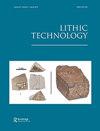New Analysis of Unifacially Shaped Technology from the Tropical Lowlands of Colombia
IF 1.2
3区 社会学
Q2 ANTHROPOLOGY
引用次数: 0
Abstract
ABSTRACTThe Middle Magdalena River Valley in central Colombia provides evidence of early human occupation between 13000 and 12000 cal BP during the global Younger Dryas period, characterized by mixed lithic industries involving both bifacial and unifacial technology. This article describes a unifacially shaped artifact discovered in the locality of Puerto Berrío, Antioquia, Middle Magdalena, central Colombia. Due to its high diagnostic value, a detailed technological analysis of its manufacture is presented to enable comparisons with similar artifacts in South America. Techno-structural analysis reveals a complexly manufactured piece with different tools, suggesting different usages. Various manifestations of this type of highly curated tool have been found in various regions of northern South America during the Pleistocene-Holocene transition, indicating that unifacial technology is a characteristic tool type of this stage, beyond projectile points. This article also aims to open a dialogue on what a tropical lithic tool is in its individuality and variability.KEYWORDS: Middle Magdalena river valleyearly peopling of the AmericasColombiaunifacial technologycurated technology AcknowledgmentsWe deeply appreciate the help of our colleagues at the Universidad Tecnológica de Pereira (UTP) during the collection analysis stay. We would like to thank the support of the Fundación de Investigaciones Arqueológicas Nacionales and the Temple University (TU) of Philadelphia, USA. We would also be grateful to express a special thanks to Marcellus d’Almeida for his recommendations on technical illustrations.Disclosure StatementNo potential conflict of interest was reported by the author(s).Notes1 The terminology associated with the description of South American unifacial technology remains problematic. Various authors have been primarily inspired by the original morphological typology of François Bordes (Citation1961). Although many authors have wrongly used the term « limace » to refer to the South American unifacially shaped tools, « limace » refers to a specific type of south american tool with specific morphological, technological and structural features, as recent defined by Lourdeau (Citation2010, Citation2015) and Moreno & López (Citation2023).Additional informationFundingThis work is part of M. González-Varas’s doctoral research, which has received financial support from the AnTET Team (Anthropologie des techniques, des espaces et des territoires au Pliocène et au Pléistocène) and the UMR 7041 ArScAn Equipe AnTET (Archéologies et Sciences de l’Antiquité)哥伦比亚热带低地单形技术的新分析
哥伦比亚中部的马格达莱纳河谷中部为全球新仙女木时期13000 - 12000 cal BP之间的早期人类活动提供了证据,其特征是双面和单面混合的石器工业。这篇文章描述了在波多黎各Berrío,安蒂奥基亚,中马格达莱纳,哥伦比亚中部地区发现的一件形状统一的人工制品。由于其高诊断价值,详细的技术分析,其制造提出,使与南美洲类似的文物进行比较。技术结构分析揭示了一个复杂的制造件与不同的工具,暗示不同的用途。在更新世-全新世过渡时期,在南美洲北部的不同地区发现了这种高度精心设计的工具的各种表现形式,表明单面技术是这一阶段的特征工具类型,超越了抛射点。这篇文章也旨在开启一场对话,探讨热带石器工具的个性和可变性。关键词:马格达莱纳河流域中部美洲年化人口哥伦比亚单面技术策展技术致谢我们非常感谢Tecnológica de Pereira (UTP)大学同事在收集分析期间提供的帮助。我们要感谢Fundación de Investigaciones Arqueológicas Nacionales和美国费城坦普尔大学(TU)的支持。我们还要特别感谢Marcellus d 'Almeida就技术说明提出的建议。披露声明作者未报告潜在的利益冲突。注1与南美单面技术描述相关的术语仍然存在问题。许多作者的灵感主要来自于franois Bordes的原始形态类型(Citation1961)。尽管许多作者错误地使用术语“limace”来指代南美的单一形工具,“limace”指的是具有特定形态、技术和结构特征的特定类型的南美工具,正如最近由Lourdeau (Citation2010, Citation2015)和Moreno & López (Citation2023)所定义的那样。本研究是González-Varas博士研究的一部分,得到了anet小组(人类技术、空间和领土、plico和plico)和UMR 7041 ArScAn equipment anet (archogies et Sciences de l’antiquit)的资助。
本文章由计算机程序翻译,如有差异,请以英文原文为准。
求助全文
约1分钟内获得全文
求助全文

 求助内容:
求助内容: 应助结果提醒方式:
应助结果提醒方式:


